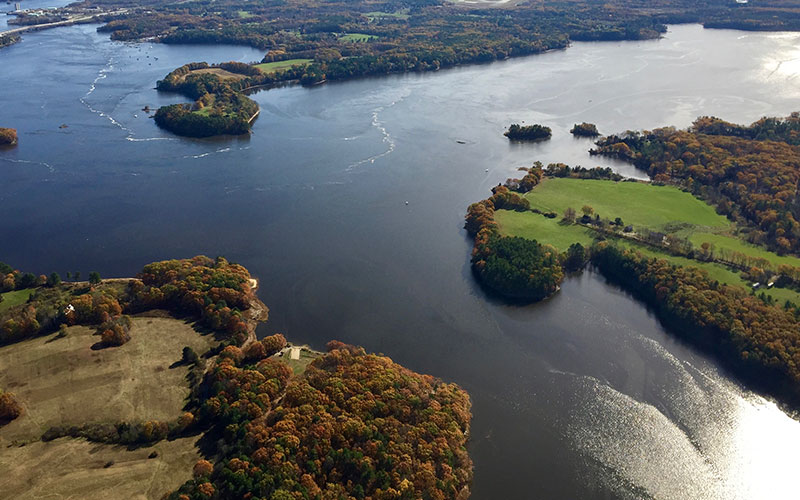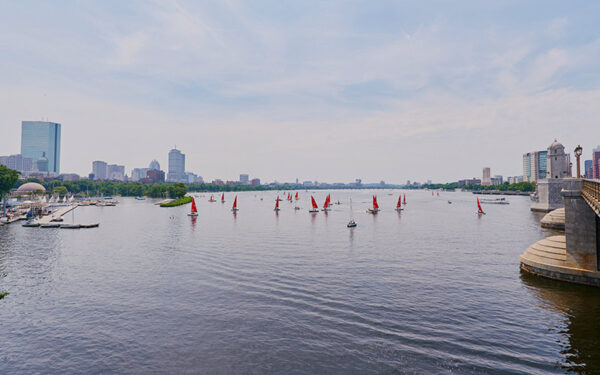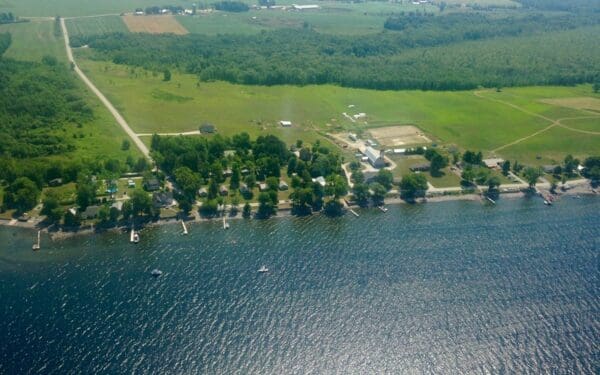
A new study shows how cities and towns in the Great Bay watershed could seriously tackle nitrogen pollution and improve the health of the estuary. Photo: Lighthawk
The Great Bay estuary of coastal New Hampshire and southern Maine once abounded with vast underwater meadows of healthy seagrasses. But since the 1990s, we’ve lost nearly half the acreage of these lush green beds, and along with it the benefits they provide.
Instead, we now see expanses of thin and sickly plants, barren bottom, and increases in invasive algae that make it harder for the fish, shellfish, birds, and other animals that live here to survive.
A primary culprit in this dramatic transformation? Nitrogen pollution. Flowing into the Great Bay from wastewater treatment facilities and septic systems, and off of streets, parking lots, and even our own lawns, this pollution leads to the unhealthy conditions now plaguing the estuary.
The Environmental Protection Agency (EPA) has proposed a new approach to reducing this harmful pollution. If adopted, it would require some communities in the Great Bay watershed to improve treatment of wastewater discharged into our rivers from sewage facilities. The permit also gives them the option of reducing 45% of the nitrogen pollution that flows into our waterways through stormwater runoff and sources such as septic systems over a very lengthy 20-year period.
A new study shows that communities can hit this target – and provides a road map for how to get there. With less nitrogen pollution, the Great Bay can begin to recover. It’s possible to restore the eelgrass and the benefits it provides to the ecosystem, from providing critically important habitat to sequestering carbon.
Study shows how cities and towns can take on nitrogen pollution
As CLF’s Great Bay-Piscataqua Waterkeeper, I have followed the EPA’s new proposal closely. To help shape CLF’s response to it, I wanted to know if the communities impacted by the permit could hit the 45% target by reducing nitrogen from sources other than wastewater treatment facilities. And if so, at what cost?
Dr. Robert Roseen, a leading stormwater management consultant who has done engineering work for many communities in the Great Bay region, answers these questions in his Feasibility Analysis, a study commissioned by CLF. It shows how 16 cities and towns in the Great Bay watershed could seriously tackle nitrogen pollution and improve the health of the estuary as a result.
Here is what the feasibility study found:
- Cities and towns can make the changes needed to meet EPA’s proposed 45% reduction at costs within national norms. And they could do so while still allowing for growth and development.
- The costs should be spread across the largest polluters, not just residents. If residents paid the entire cost, the annual average bill would be $91 per household. However, nearly half of the improvements suggested by the analysis could – and should – be implemented by commercial, industrial, and institutional property owners. Their large buildings and parking lots are a significant source of stormwater pollution. Such a shift would greatly reduce the annual average cost to residents and more equitably spread the responsibility of addressing the problem.
- The goals of the proposed permit are achievable and affordable: The stormwater components of the permit would cost an estimated $145 million over 20 years. While this is still a significant cost, it’s a far cry from the assertions of some cities and towns that the permit would cost over $1 billion and completely stifle new growth. And because the permit would stretch over 20 years, these costs can be spread out over time, systematically built into capital improvement budgets, and addressed through tighter ordinances on how land is developed so it doesn’t generate stormwater pollution.
Creative thinking to restore our estuary
EPA’s proposed permit could trigger communities to develop innovative approaches to reducing nitrogen pollution. One idea is nitrogen trading, similar to carbon trading. For example, a more densely developed community could pay for protecting stream corridors that absorb stormwater runoff in a more rural town. For their investment, the urban community would get credit for the nitrogen pollution averted.
There is also a need for new state rules on certain fronts, like fertilizer restrictions and improved septic system codes near waterways. Because the rivers, bays, and coast of the Great Bay estuary are a resource – and economic engine – of statewide significance, more protective statewide regulations are justified and would ease some pressure on individual municipalities to have to “reinvent the wheel.”
A road map toward a healthier estuary
Many communities in the Great Bay watershed have been making significant progress in improving water quality with investments in their sewage treatment facilities. But because a large fraction of the pollution fouling the Great Bay estuary comes from stormwater and septic systems, there is still important work to be done.
The Feasibility Study commissioned by CLF provides a road map for ways that communities and the state can work systematically and affordably over time to reduce stormwater pollution and restore the health of the Seacoast region’s rivers, bays, and coast.
You can help: Urge your town and city council, planning board, and other local commissions to adopt rules for new development and re-development with strict stormwater management requirements. You can also express your support for investments in clean water initiatives.



